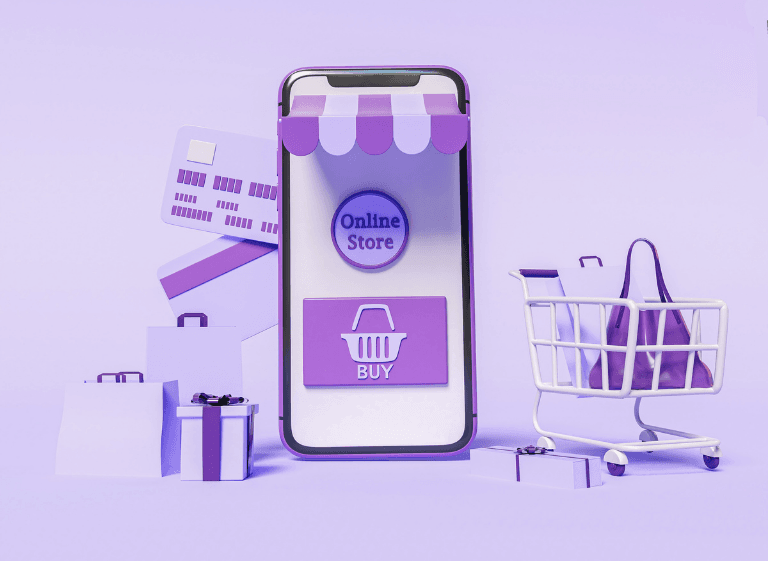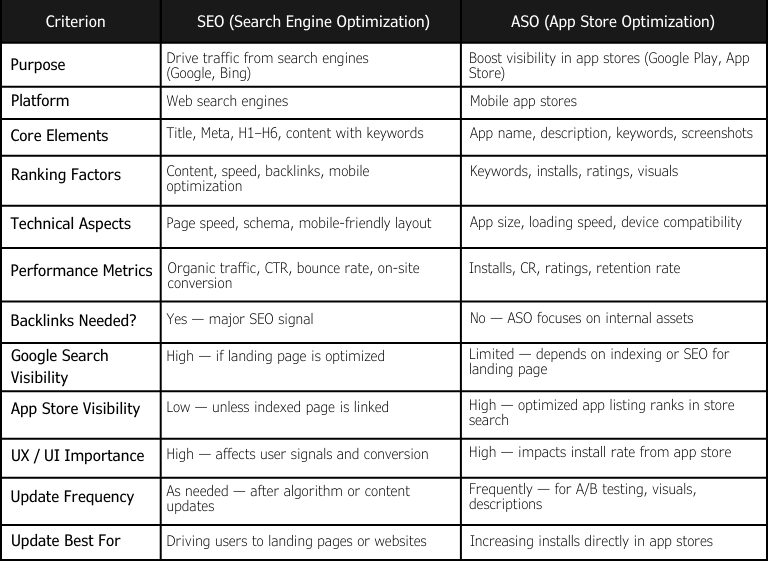SEO
Mobile development
How SEO Drives Growth and Visibility for Mobile Shopping Apps
Iliya Timohin
2025-03-24
In a digital marketplace where 5.6 million mobile apps compete for attention, your shopping app risks becoming just another icon lost in the endless scroll. While developers obsess over flashy features and sleek interfaces, the harsh reality remains: an invisible app generates zero revenue, regardless of its brilliance. The strategic implementation of search engine optimization isn't merely a marketing tactic — it's the difference between your retail app thriving as a digital storefront or collecting virtual dust in the shadows of app stores. As mobile commerce continues to reshape consumer behavior, mastering both traditional SEO and app store optimization has become the critical foundation that transforms promising shopping applications into discoverable, growth-driven platforms that users actually find.

Why SEO Is Essential for Mobile Shopping Apps
SEO vs. ASO: Key Differences and Why Both Matter
While SEO focuses on optimizing content and websites for search engines, app store optimization (ASO) is specifically tailored for app stores. Both strategies are essential for mobile shopping apps. SEO helps improve visibility in search engines like Google, while ASO enhances discoverability within app stores like Google Play and Apple App Store. Understanding the differences and utilizing both approaches can significantly impact user acquisition and retention. These dual strategies are especially important as shopping applications continue changing the way users interact with digital commerce.
To fully understand how SEO and ASO contribute to app growth, it’s important to compare their goals, components, and performance metrics side by side. The table below outlines the key differences and similarities between SEO and ASO for mobile shopping apps.

Key SEO Strategies to Boost Mobile App Visibility
Google AMP for Faster Mobile Pages & Better SEO
Google’s Accelerated Mobile Pages (AMP) is a game-changer for mobile shopping apps. AMP enhances page load speed, providing users with a smoother and faster browsing experience. For platforms like Opencart, Cs-Cart, or Prestashop, businesses can leverage solutions that integrate Google AMP for SEO to implement this optimization effectively.
Why Page Speed Is Crucial for Mobile Shopping Apps
Page speed is a critical factor affecting user experience and conversion rates. Studies show that even a one-second delay in loading time can lead to a significant drop in conversions. Therefore, optimizing your mobile app’s pages for speed is essential for retaining users and driving sales. Google emphasizes this in their official SEO Starter Guide, where they highlight speed as a ranking factor.
Key benefits of implementing AMP for mobile apps:
- Boosts page speed on mobile devices
- Improves user engagement through faster browsing
- Increases chances of higher rankings in Google mobile search
How AMP Improves Rankings and User Experience
By implementing AMP, mobile shopping apps can achieve faster load times, which in turn improves search engine rankings. Google prioritizes fast-loading pages in its search results, meaning that apps utilizing AMP are more likely to appear at the top of search listings, driving more traffic and engagement. For a deeper dive into mobile SEO practices, see this guide by Search Engine Journal.
Optimizing Navigation with SEO-Friendly Product Filters
Effective navigation is key to enhancing the user experience in mobile shopping apps. Implementing SEO-optimized filtering tools, especially for platforms like Opencart and Prestashop, can significantly improve searchability within the app.
How Structured Product Categories Improve Searchability
Organizing products into structured categories allows users to find what they’re looking for quickly and efficiently. This not only enhances the shopping experience but also improves the app’s visibility in search engines. Google’s best practices on URL structures for ecommerce sites recommend logical, user-friendly navigation as part of mobile SEO.
Best Practices for Implementing SEO-Friendly Filters
To create effective SEO-friendly product filters, consider using descriptive keywords in filter names and ensuring that these filters are easy to navigate. This approach not only helps users find products but also contributes to the overall SEO strategy. Additional developer-focused tips are available in Google’s SEO guide for web developers.
Tips for creating SEO-friendly product filters:
- Use descriptive, keyword-rich filter labels
- Ensure filter URLs are crawlable by search engines
- Avoid duplicate content by canonicalizing filter pages
Mobile-First Indexing & UX: Why It Matters for E-Commerce Apps
Google’s mobile-first indexing means that the search engine predominantly uses the mobile version of a website for indexing and ranking. This shift underscores the importance of prioritizing mobile optimization for e-commerce apps.
How to improve UX for mobile-first indexing:
- Design with mobile screen sizes in mind first
- Keep menus and navigation minimal and intuitive
- Prioritize loading speed and performance
Google's Mobile-First Approach and Its Impact on Rankings
With mobile-first indexing, Google evaluates how well a mobile app or site performs on mobile devices. Apps that are optimized for mobile experiences are more likely to rank higher in search results, attracting more users.
How to Create a Seamless UX for Better Engagement
Creating a seamless user experience (UX) involves optimizing layout, navigation, and load times specifically for mobile users. A well-designed UX keeps users engaged and encourages them to explore the app further, leading to higher conversion rates.
How to Use Content & Keywords to Rank Higher in Mobile Search
The Role of Long-Tail Keywords in Mobile Search Optimization
Long-tail keywords are specific phrases that users are likely to search for. For mobile shopping apps, targeting these keywords can lead to higher visibility and engagement.
Why long-tail keywords work for mobile apps:
- Lower competition compared to short keywords
- Higher purchase intent from users
- Easier to rank for specific niches or products
Why Long-Tail Queries Matter for Mobile Shopping Apps
Long-tail queries often have lower competition and higher conversion rates, making them ideal for mobile shopping apps. By focusing on these specific phrases, brands can attract users who are further along in the buying process.
How to Find and Use High-Converting Keywords
Utilizing keyword research tools can help identify high-converting long-tail keywords. Incorporating these keywords into app descriptions, product titles, and content can significantly improve search rankings.
Leveraging Rich Snippets & Schema Markup for Mobile Shopping Apps
How Schema Markup Improves Mobile Search Visibility
Schema markup helps search engines understand the content of a webpage more effectively, which can lead to enhanced search results, such as displaying product ratings or pricing directly in search listings.
Examples of Structured Data That Enhance Search Results
Implementing structured data for products, reviews, and pricing can make mobile shopping apps stand out in search results, increasing click-through rates and driving more traffic.
Common SEO Mistakes That Can Harm Your Mobile App Rankings
Poor Page Speed & Slow Load Times
One of the most critical factors affecting mobile app rankings is page speed. Slow-loading pages can lead to higher bounce rates and lower conversions.
Top 3 SEO mistakes to avoid:
- Ignoring mobile performance and page speed
- Failing to implement app indexing and deep linking
- Using generic keywords instead of long-tail queries
How Slow-Loading Pages Affect Rankings and Conversions
Google penalizes slow-loading pages in search rankings, meaning that apps with poor performance will struggle to gain visibility. Additionally, users are less likely to complete purchases if they experience delays.
Tools to Test and Improve Mobile Page Speed
Using tools like Google PageSpeed Insights or GTmetrix can help identify issues affecting load times. Implementing suggested optimizations can enhance performance and improve search rankings.
Neglecting App Indexing & Deep Linking
Why App Indexing Is Critical for Mobile SEO
App indexing allows search engines to include app content in search results, making it easier for users to find specific products or pages within the app.
How Deep Linking Enhances Discoverability and User Retention
Deep linking directs users to specific content within the app, improving the user experience and encouraging retention. By facilitating direct access to relevant products or promotions, deep linking can significantly enhance user engagement.

Conclusion
The Future of Mobile Shopping Apps & SEO
Why Ongoing SEO Optimization Is Essential for Mobile Commerce
As mobile commerce continues to grow, the importance of ongoing SEO optimization cannot be overstated. Regularly updating and refining SEO strategies will help mobile shopping apps maintain visibility and competitiveness in the market.
SEO tips to future-proof your mobile shopping app:
- Regularly audit your app’s SEO performance
- Monitor mobile search trends and update accordingly
- Combine ASO with SEO for full visibility coverage
Predictions for Mobile Search Trends in the Coming Years
As technology evolves, mobile search trends are likely to shift toward greater personalization, voice search, and enhanced user experiences. Staying ahead of these trends will be crucial for mobile shopping apps looking to attract and retain users.
FAQ: Mobile SEO for Shopping Apps
1. What’s the difference between SEO and ASO for mobile shopping apps?
SEO helps apps appear in search engine results like Google, while ASO improves visibility in app stores like Google Play and Apple App Store. Both are crucial for full exposure.
2. Why is AMP important for mobile shopping apps?
AMP (Accelerated Mobile Pages) makes content load faster on mobile devices, which improves user experience and helps apps rank higher in search results.
3. How can product filters be SEO-friendly in eCommerce apps?
Use keyword-rich filter names, create crawlable URLs, and structure categories clearly to enhance visibility and avoid duplicate content.
4. What is mobile-first indexing and why does it matter?
Mobile-first indexing means Google evaluates the mobile version of your app or site first when ranking. If your app isn’t optimized for mobile, it can hurt your rankings.
5. How do long-tail keywords help mobile apps rank better?
Long-tail keywords target specific user intent, have lower competition, and often result in higher conversion rates — perfect for reaching users closer to purchase.
6. What is deep linking in mobile apps?
Deep linking sends users directly to a specific screen or product inside your app, improving UX and increasing user retention and engagement.
7. What are common SEO mistakes mobile shopping apps should avoid?
The most common mistakes include slow page load times, missing deep links or app indexing, and ignoring mobile UX design.
8. How often should I update my app’s SEO strategy?
SEO should be monitored monthly and updated quarterly or when major changes occur in Google’s algorithms, user behavior, or your app’s structure/content.
9. Can SEO really help drive installs for mobile apps?
Yes — by improving visibility in search engines, SEO can drive qualified traffic to your app’s landing page, increasing both installs and in-app conversions.
10. How do schema markups help mobile shopping apps?
Schema helps search engines understand your app content better and display rich results like product ratings, prices, and reviews directly in Google Search.